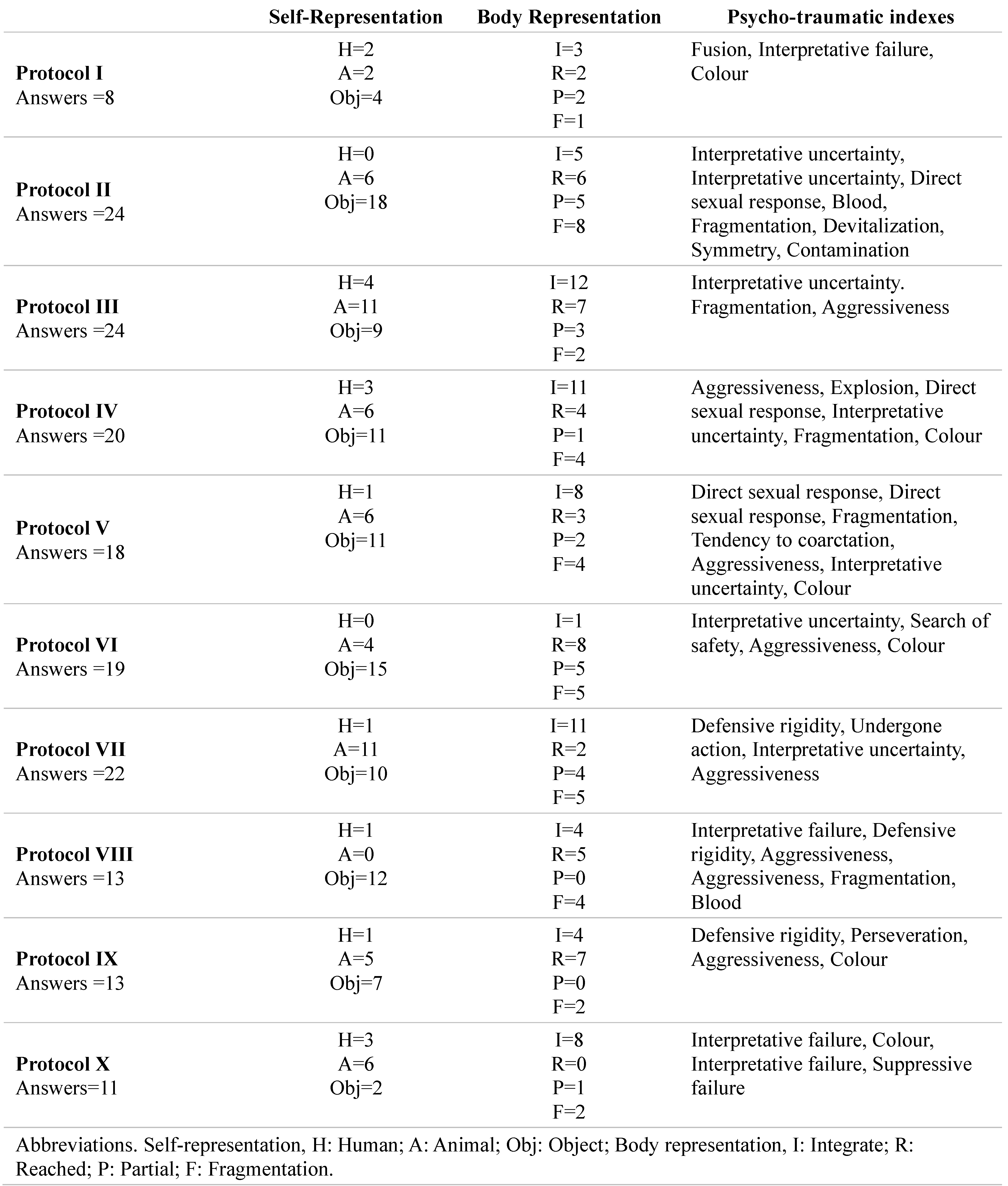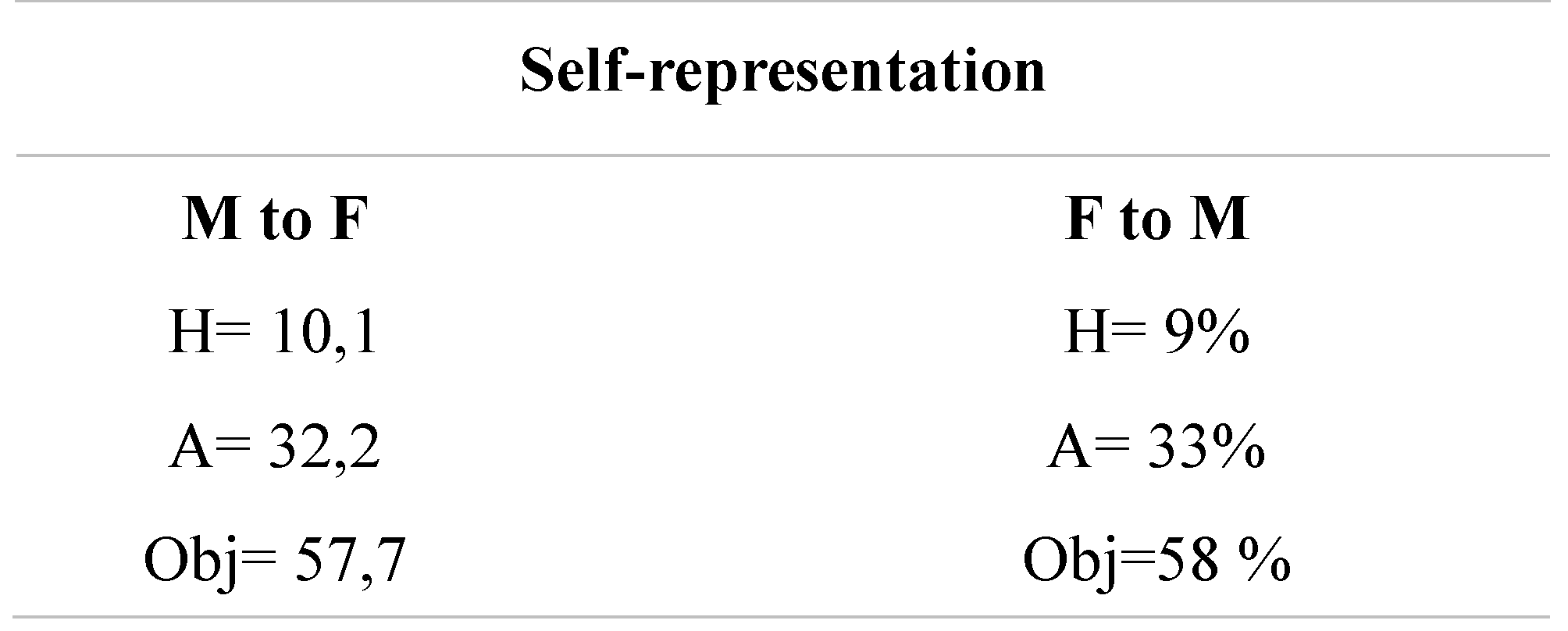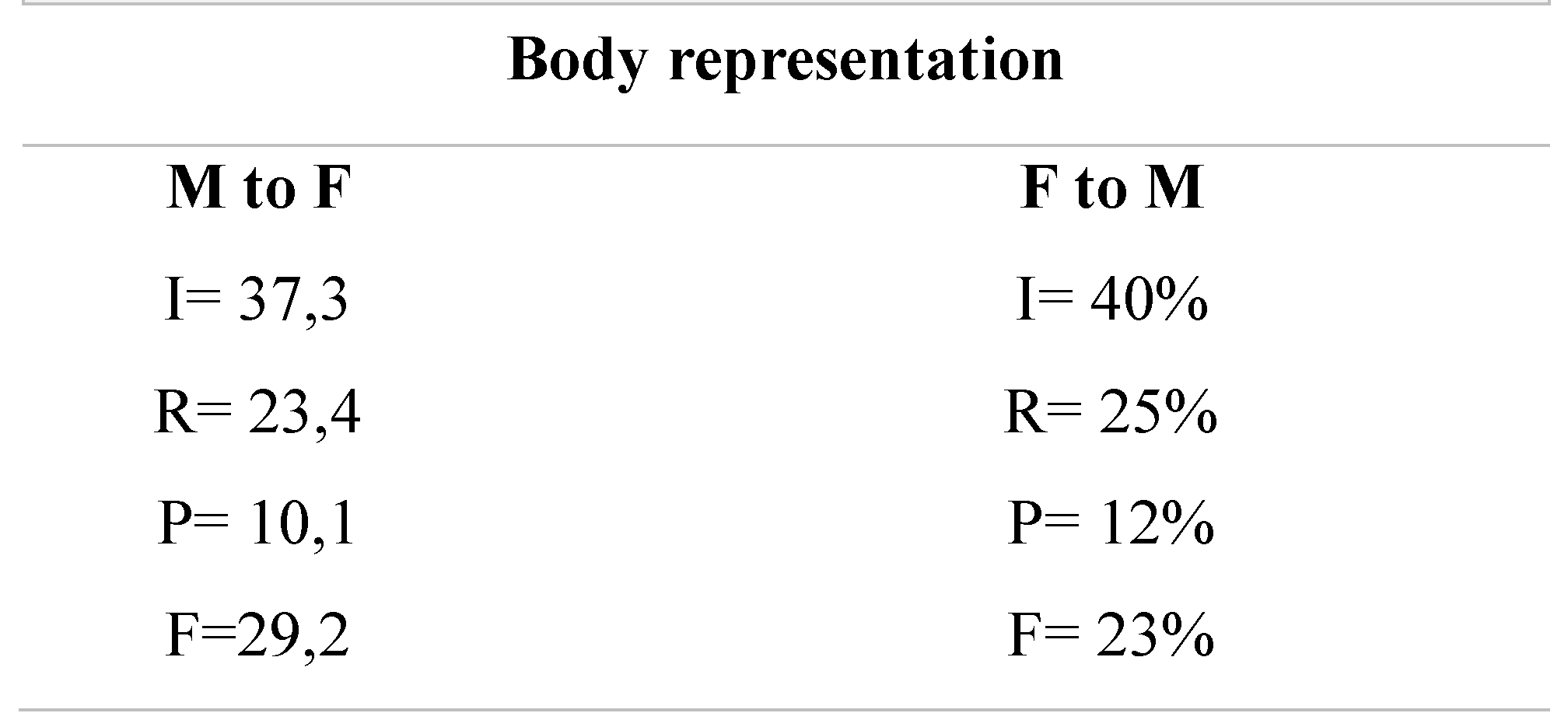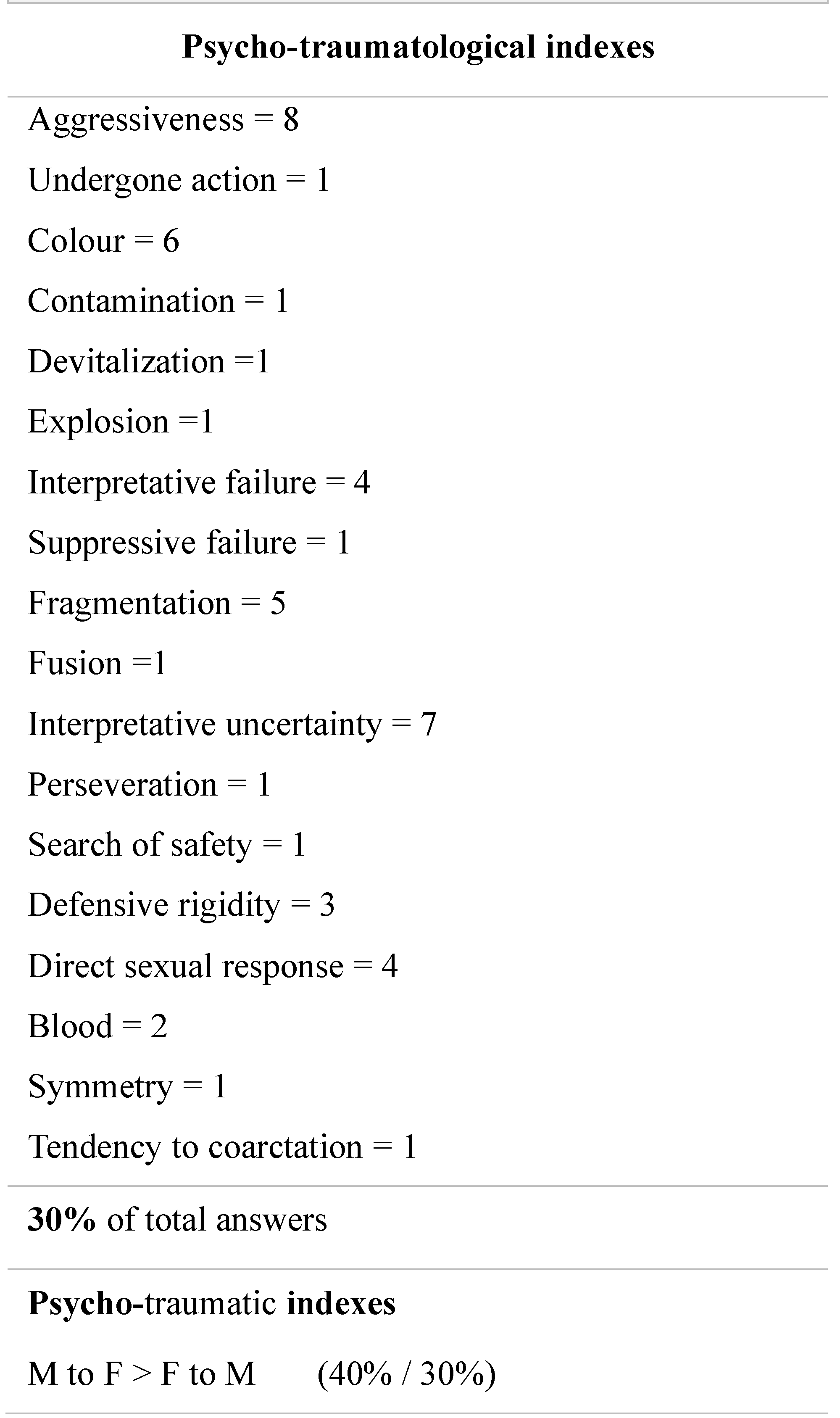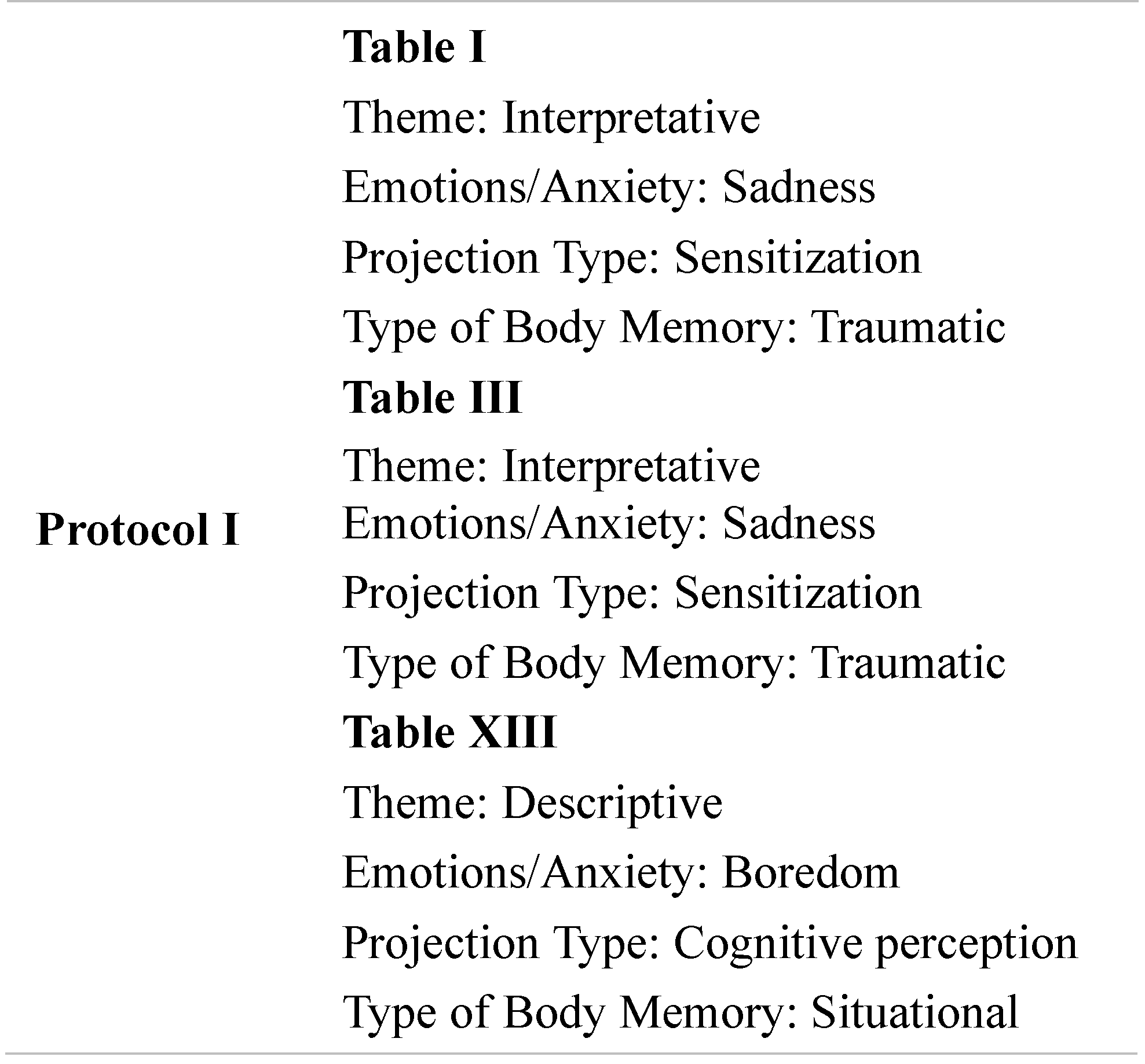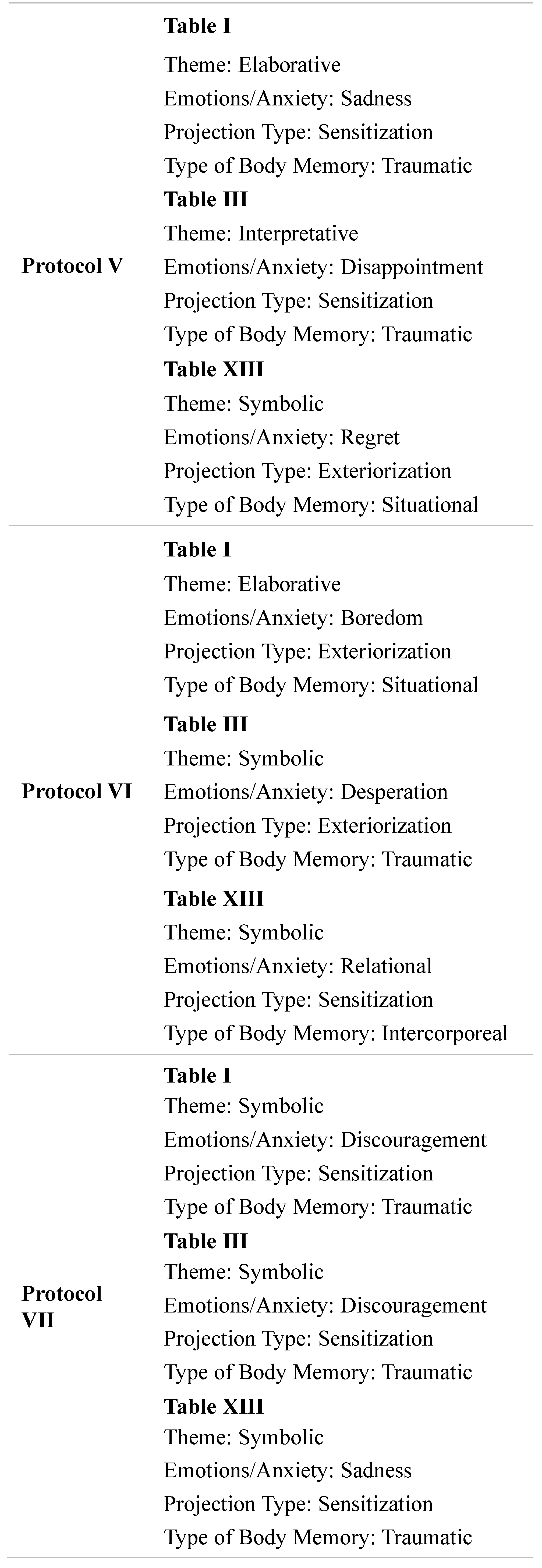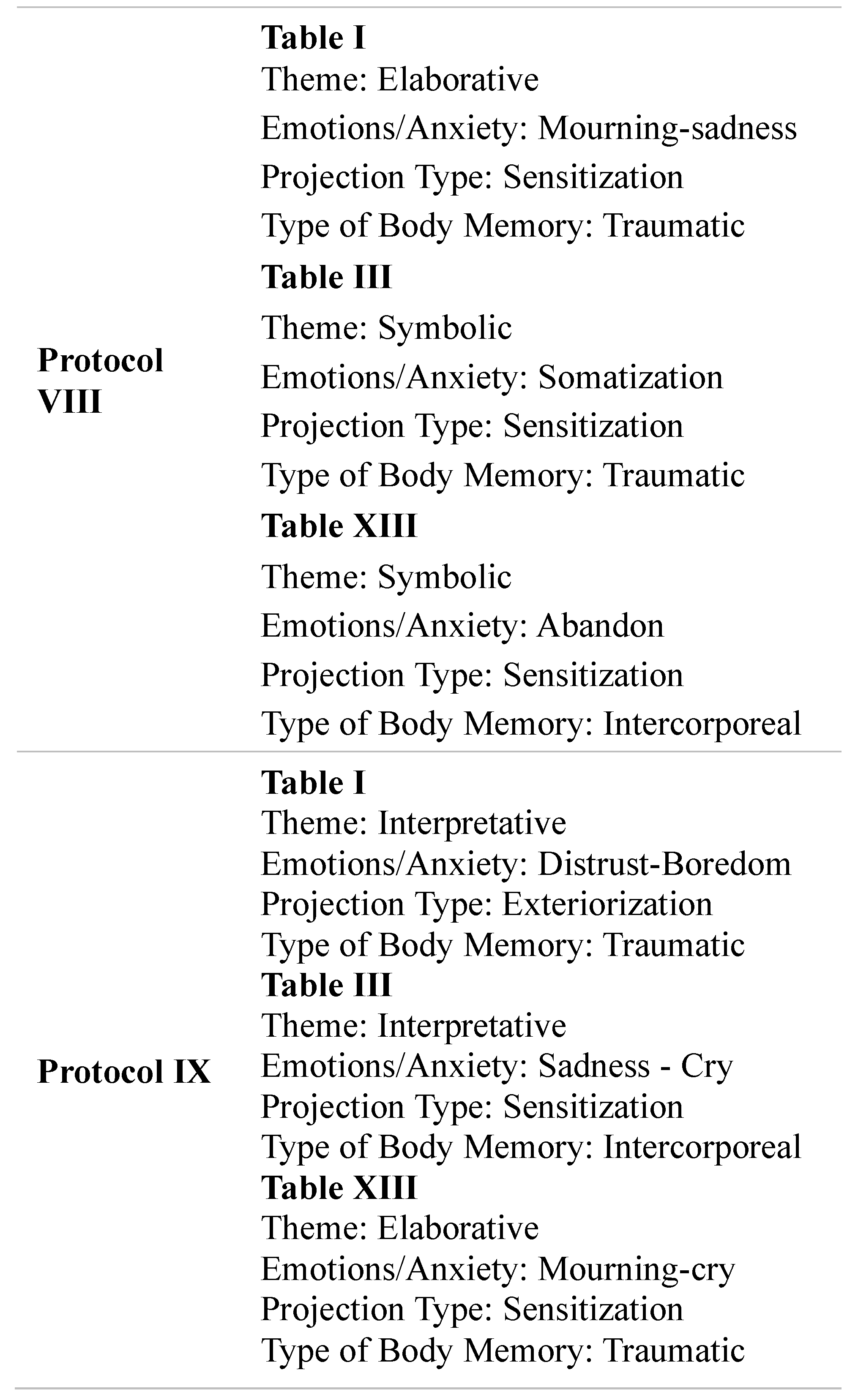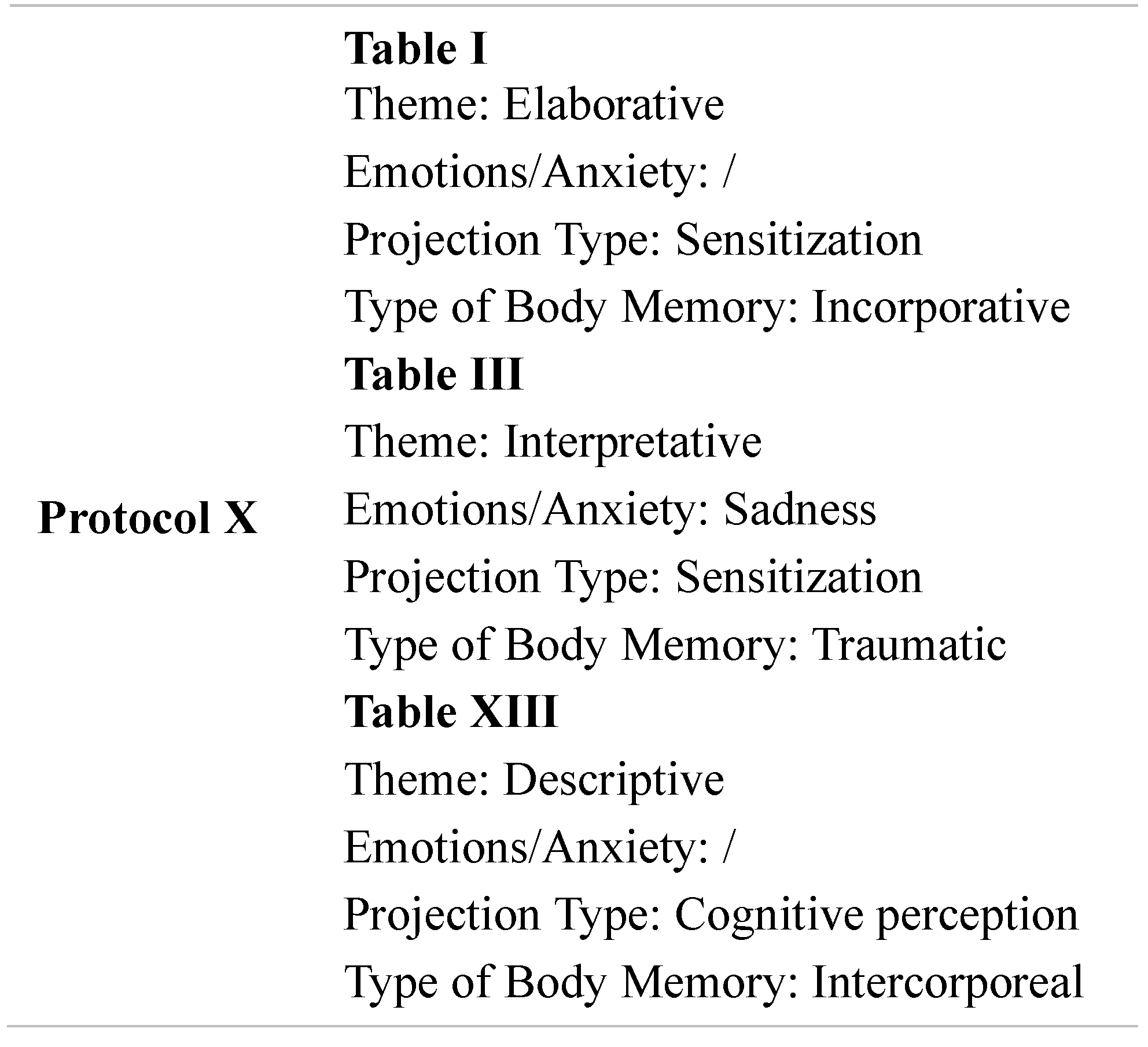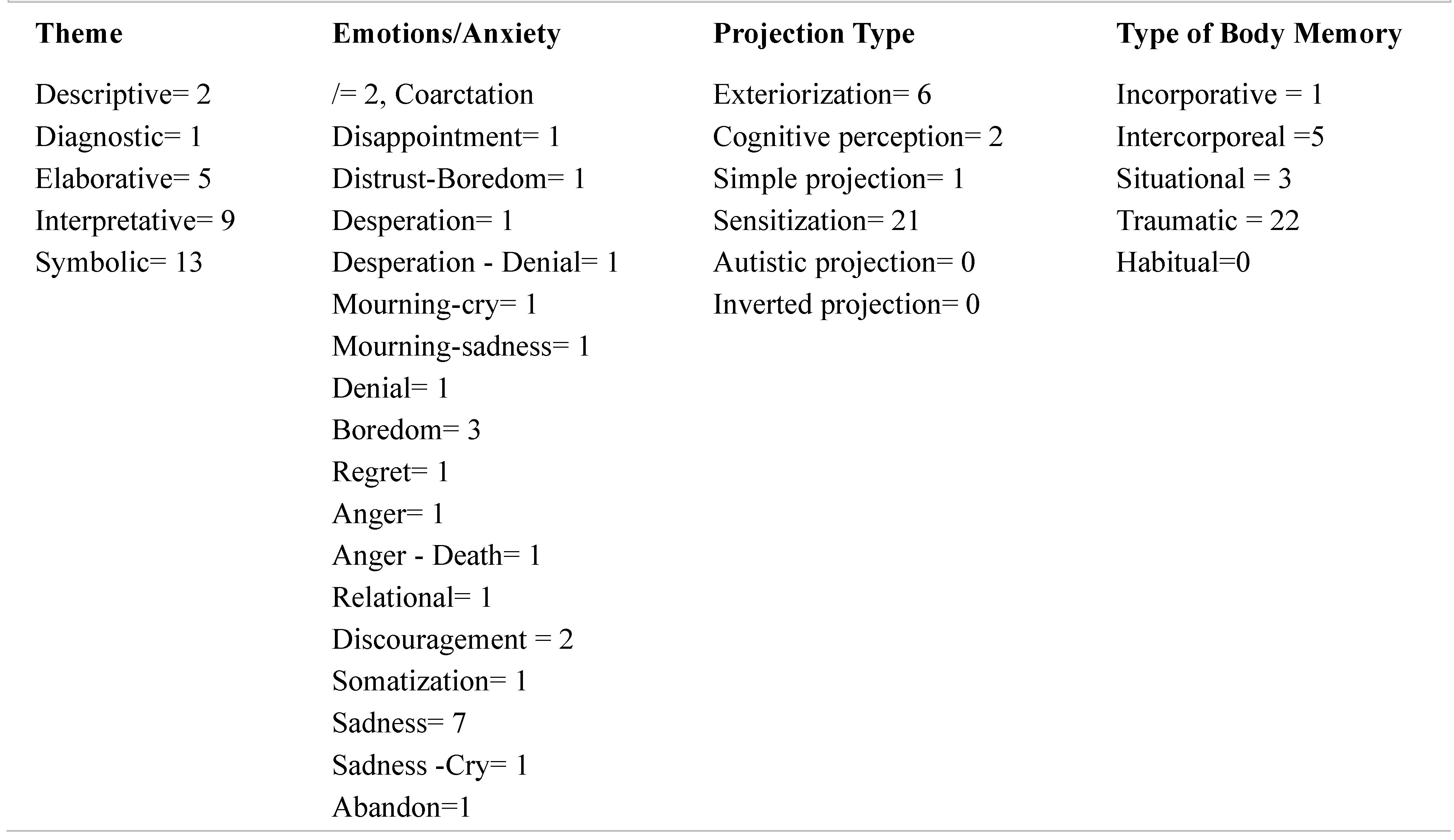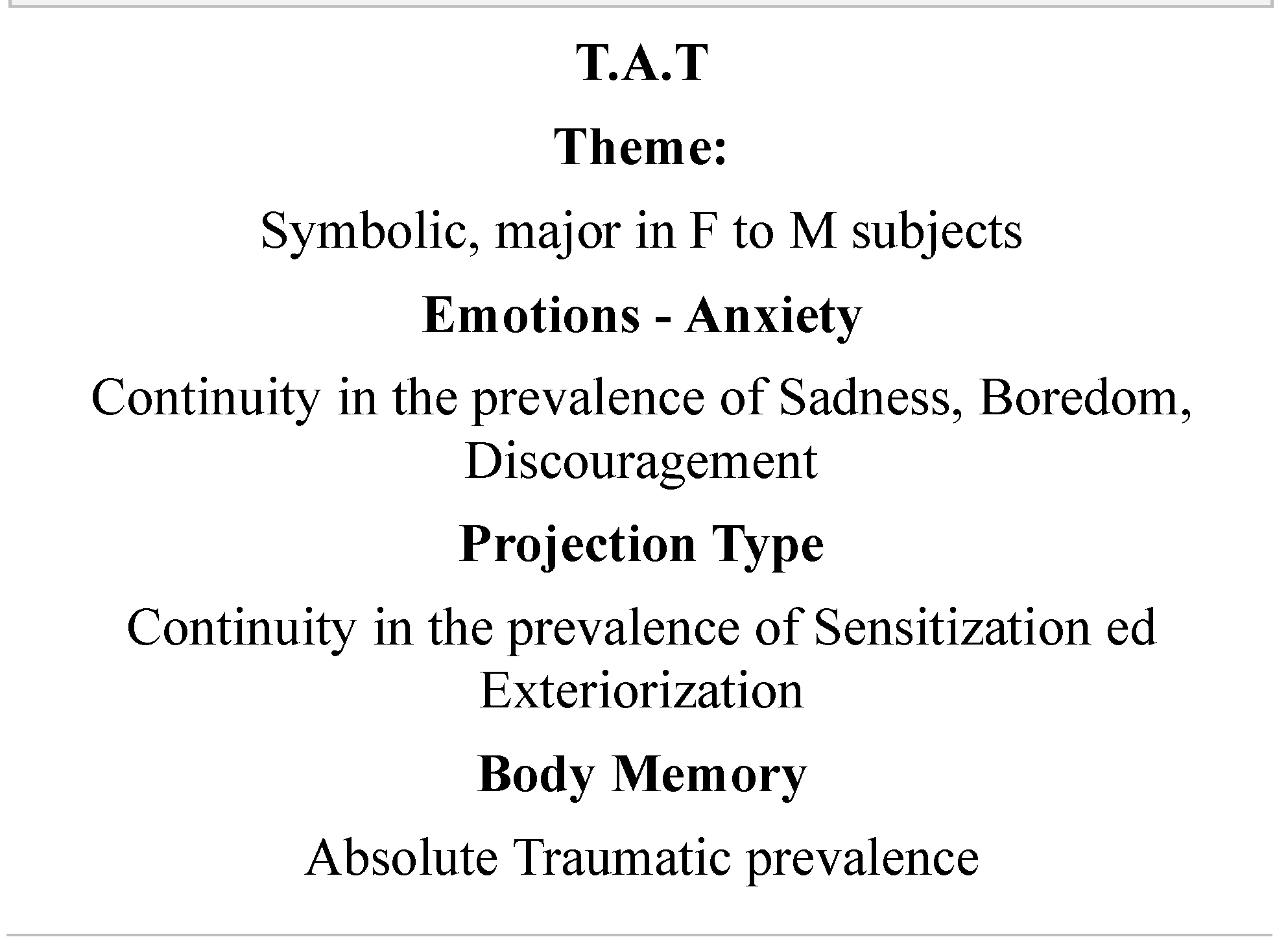Introduction
From our experience with Gender Dysphoric patients, the first interesting fact refers to the diagnostic question. In this specific case, the request is double and refers to the recognition of the condition and the exclusion of active psychopathology.
The psychopathological issue is fundamental, since the condition is no longer considered a disorder, DSM 5 [
1]. The request to exclude the presence of psychopathology makes sense since the patients will then have to undergo endocrinologic and surgical treatments [
2]. This refers to the different conditions arising in the clinical field with LGBT subjects, since socio-demographic variables and age represent relevant aspects [
3].
Therefore, the need to consider the patients’ associated conditions provides different outcomes. The first refers to the recognition of the condition of Gender Dysphoria, with no presence of psychopathology. The second case refers to the coexistence of Gender Dysphoria and psychopathological factors whose compensation appears as possible.
Primarily, our work requires the avoidance of all disturbing factors that prevent clinicians from being objective. The most common phenomena are known in the light of lack of knowledge, together with minority stress, resilience and general health status [
4,
5,
6].
Phenomenology allows us to grasp the phenomena in the way they manifest themselves [
7] and to consider them in the light of effective and objective clinical reasoning related to the subjects’ world projects [
8]. With particular reference to psychic objects [
9], our study took into consideration intentionality, with logical reference to Brentano [
10]. The way in which the subjects are directed towards objects and their nature informs us about personality structures and possible deviations from the adaptation process. This must take place with the application of a method based on the suspension of judgment (epochè), phenomenological reduction and inference as fundamental factors.
From our perspective, the derivation of the used assessment instruments can be considered both phenomenological and dynamic, for the following reasons: it makes the applications of clinical psychology possible, addressing the various fields of application in healthcare and hospital contexts [
11], in consideration with the existentially known and unknown possibilities of the subjects [
12].
Pareidolia [
7,
13,
14] represents the basic phenomenon through which it is possible to access the subjects’ representations [
15] of the things. This is the case of the Rorschach method, which is one of the most used psychodiagnostic methods in the study of personality structures. The study of the inner phenomena allows us to take into account inner structures and to consider horizontal dynamics with respect to the unconscious [
16].
The contributions to the study of Rorschach’s pareidolia provided by Nina Rauch de Traubenberg [
17,
18] makes us get in touch with both corporeality and affectivity. This fact is of fundamental importance, since the functioning of the subjects under examination could be considered to be characterized by a peculiar form of mind- body dualism.
This emerging data can be compared with non- dysphoric conditions, such as binary sexual identity [
19]. We therefore consider the images as a form of knowledge [
20], that can witness the subjects’ adaptation- maladaptation processes. The fundamental difference between perception and representation is taken into account through the representations by means of which we can access the unconscious dynamics of the subjects.
The second phenomenon taken into consideration by this study is apperception. This transversal phenomenon is understood given the studies of Herbart [
21], Lange [
22], Stout [
23]. It can be defined as a process through which every new experience is assimilated and transformed on the basis of the entire previous experience. The set of experiences that tend to filter subsequent perceptions and representations is called the apperceptive mass.
It is therefore possible to grasp the dynamics of the apperceptive mass, on the basis of the new experiences just lived. The best-known apperception-based psychodiagnostic method is Murray’s Thematic Apperception Test [
24]. The theoretical and methodological particularities underlying the methodology adopted will be discussed below.
Our research is linked to the dynamics expressed by previous studies that investigated the corporeality of the subjects. It is necessary to clarify that the dynamics related to corporeality have undergone a theoretical evolution. Fuchs [
16], suggested the fundamental concept of body memory, that in our case refers to the fixation of habitual styles, considered in the light of an existential style [
25,
26]. This style is built on the basis of all fixations and sedimentations, with reference to corporeality, psychological and cognitive experiences as implicit memory [
27].
In the case of the Fuchs studies [
28,
29,
30,
31], it was possible to identify precise, habitual, traumatic, situational, inter- corporeal and incorporative styles. These styles were considered in previous research on Dysphoric patients of M to F Gender [
26], which reported Sabrine C. Koch’s original definition [
32].
Our contribution proposed a methodological and theoretical integration in which fundamental, representational and apperceptive moves were extended following the categories of Body Memory, Representation of the Self and the Body.
The transversal factor is therefore corporeality in relation with the dualistic mind-body dynamics, through which it is possible to infer the experience of our subjects. The present research was aimed at extending the following methodology from M to F Gender Dysphoric patients [
26,
33] to F to M patients, in order to highlight possible common figures and differences between the two groups.
Results
Results of comparison between TAT F to M and TAT M to F (Current 10 F to M protocols).
In
Table 1, the complete analysis related to the subjects’ Rorschach protocols was reported. The analysis involved Rorschach Self and Body representations, respectively represented by human, animal and objectual contents for Self and integrate, reached, partial and fragmentation of the Body.
Moreover, since most of Rorschach responses resulted as psycho-traumatic, in accordance with the previous studies, the psycho-traumatic indexes were provided.
As it follows (
Table 2), the data were reported within a summary table, in order to highlight the significance of emerged indexes.
Abbreviations. Self-representation, H: Human; A: Animal; Obj: Object; Body representation, I: Integrate; R: Reached; P: Partial; F: Fragmentation.
In terms of Self representation, a prevalence of objectual contents has emerged. The data will be compared to previous M to F studies. It was possible to notice the relevance of affected Self representation, whose inference would be linked to the declared dichotomy and discrepancy. In the specific case, the affective investment towards human objects resulted low, so that the data explained the strong request of adhering to reassignment programs. In continuity with Self representation, Body dynamics highlighted the presence of fragmentation and partial contents. The continuity is meant as a high level of unexpected contents, due to just treated dynamics. Body contents was represented by partial and fragmented objects, suggesting a state of uncertainty and intolerability of the current body status.
The comparison between the two groups (F to M and M to F) highlighted an important continuity about the results. For both Self and Body representations, the indexes were paired as reported in
Table 3.
The Body representation indexes respected the above- mentioned continuity, but rather for the M to F fragmentation index. In this particular case, a prevalence of M to F fragmented representations has emerged. The global tendency is close to continuity, but solely for the F index.
As reported in
Table 5, a prevalence in psycho- traumatic indexes emerged within the comparison between F to M and M to F indexes. With particular reference to F to M subjects, the index pointed out the 30% of the traumatic representations. In terms of comparison, there was a prevalence of psycho-traumatic images for M to F subjects (40%). Finally, it was possible to demonstrate a higher presence of psycho-traumatology in M to F subjects.
The analysis carried out on the Thematic Apperception Test indexes was reported in
Table 6. In particular, three T.A.T. tables were selected (I, III, XIII), so that the subjects’ responses were analyzed with reference to Bellack Systematic study [
36], including themes, emotions, anxieties and projection types. In addition to Bellak’s analysis, the type of body memory was studied to point out the exact equivalence with the relative studies. The following summary tables (
Table 7 and
Table 8) report the specific indexes and result as emergent from the T.A.T. analysis.
With reference to themes, a prevalence of symbolic and interpretative movements has emerged. This fact highlighted the necessity of our subjects to operate a signification process on body contents, useful to distance themselves from phenomenal perception issues related to the current body form. Several emotions and anxiety issues have emerged with a marked prevalence of boredom, mourning contents, sadness and depressive contents. These issues must be considered related to the body, since the selected tables were included on the basis of their property to evoke corporeal representations. The prevalence of sensitization and exteriorization in terms of projection types, was in line with the significance of changes made in diagnostic terms.
Since Gender Dysphoria (GD) is no longer considered a mental disorder (GID), it is possible to notice how the subjects’ knowledge impacts their consciousness. Sensitization and exteriorization represent dynamics related to consciousness, so that the current knowledge about gender dysphoria influences their psychological paths. As for the M to F subjects, our observation group of F to M subjects, expressed an absolute prevalence of traumatic body memory. Compared to previous Rorscharch indexes, it was indicative of high disturbance about corporeal themes, as testified by the term dysphoria itself.
Discussions
The data presented in the results concerned numerous indexes, which require synthesis and discussion before operating an inferential process to the population. The first reference was to Rorschach, with particular attention to the data concerning the global constitution of the Self [
17]. It was interesting to note a continuity between F to M and M to F individuals, since there was a congruence in the percentage of human, animal and object representations. It is therefore possible to infer that the general data persist in gender dysphoric subjects. In particular, we noted a prevalence of object responses ranging from 57 to 58%.
This datum informed us about the constitution of the Self for gender dysphoric patients, which is mediated by representations mainly distinct from the human contents. The maturity of the Self-representation is configured on the basis of a great number of human responses and, in general, it is evidenced by prevalent vital objects [
17,
18,
26,
33].
In the case of our gender dysphoric patients, this did not happen, so that it was important to understand the degree of maturity of their global Self representation. Rausch de Traubenberg’s studies clarified this maturation process. The current state of our patients is characterized by a strong desire for sexual reassignment, so that the global representation is under construction, projected towards an integrity that is supposed to be reached through physical reassignment. Specifically, the current general and particular perceptions are inconsistent with internal images, that tend to represent the desire to belong to the opposite sexual identity. From here, we can confirm what has been premised as declared discontinuity, discrepancy and, above all, a unique form of apparent body-mind separation. Following the individuals’ declarations, the sense of unity arising from the need to unify body and mind was experienced as impossible. It would be essential to follow patients prospectively, in order to verify the possible occurring variations of their expressions.
This process would have just begun, since our observations represent the preliminary step for obtaining the authorization to proceed with hormonal therapies and sexual reassignment surgery. At present, it is possible to infer poorly adaptive dynamics related to the Self. The second important fact concerns the global body representation, studied in depth by Rausch de Traubenberg’s [
18]. The patients examined by means of the Rorschach method produced indexes representing a similar continuity with the previous M to F study, albeit variant in terms of fragmentary representations. It would be possible to state that an important number of partial and fragmentary representations were present, not foreseen in mature bodily representations. Partial responses were greater among F to M patients and the fragmentary representations were greater among M to F subjects. The results were similar, indicating the presence of fragmentation and partiality that was usually found in Gender Dysphoric subjects depending on a peculiar corporeal discomfort. The psycho-traumatic question referring to gender dysphoric subjects emerged through characteristic features. A high number of representations proved to be maladaptive for the subjects, having a disturbing psycho-traumatic role. This form of representational traumaticity is in line with what has been reported so far. There were two traumatic indexes that seem to be affecting the subjects.
The first referred to the psycho-traumatic indices of Gravenhost [
35] and the second to the body experience and sedimentations, due to the above-mentioned studies of Fuchs and Koch [
29,
30,
31,
32]. Both indices proved high, indicating a traumatic role of the current images, different from those that would plausibly take place depending on the reassignment process. The traumatic indexes referable to the Rorschach method revealed a consistent presence of psycho-traumatology among F to M subjects, although less than among M to F subjects. In terms of body memory, the transposition operated allowed us to detect an absolute prevalence of traumatic issues. This was evident in the presence of mainly interpretative and symbolic issues, indicative of prospective representation processes for reassignment. The prevalent apperceptive tendencies, in line with the conscious desire for sexual reassignment, were sensitization and externalization. Therefore, the processes of apperception appeared characterized by the full awareness of the condition (GD), by the need for symbolic variation of the current contents and by predominant negative emotions.
Overall, what has emerged revealed the intolerability of the condition and the aspects of bad endurance (dysphoria). It had been stated that, based on the previous studies and current results, gender dysphoria could be considered with particular reference to the Body-Mind Problem. The need to overcome the distinction between body and mind in our experience with gender dysphoria proves to be maintained. Although efforts to express the need for integration between the concepts of mind and body have a long history, in many approaches this conception persists. The latest developments in psychosomatic medicine seem to have sensitized this perspective [
38]. The indication is very clear and undeniable. As suggested by Flumini [
39] regarding the phenomenology of language, a phenomenological opening that takes into account human ontology is necessary. It is possible to avoid metaphysical drifts and
eliminativism through epochè. As it has reported by the author, several contributions have defined the categorical error [
40,
41] which does not exclude the propensity towards one of the two terms (i.e., Body or Mind) [
42,
43,
44,
45]. Several studies have considered the Body-Mind Problem, and it is interesting to compare the emerging results with the approaches in the literature. In a study published in 2015, the authors suggested an interrelation between two specific units, without which the study of mental facts would be ineffective [
46]. These subunits are internal-mental existence/ entity and internal-mental reality, fundamental and related phenomena. The two phenomena were considered impossible to be studied independently, to the point that their relationships would have been preliminary to the approach of the Body-Mind Problem. Specifically, the first psychological/physiological subunit (internal-mental existence), consists of human specific mental existence; the second represents the process of introjection of external reality. The authors suggested that the separation of the two subunits would represent a counterproductive fact in terms of study.
The authors stated: “
The internal-mental entity is different from the physical body, the internal-mental reality is different from environmental reality, and the mental interaction is also different from physical interaction. In other words, this model would suggest that there is actually no “mind-body problem”. In our case, it was considered interesting to propose a particular functioning mode, which seems to be committed to affirming the existence of a Body Mind Problem. On the surface, the solution to the problem would coincide with the request for sexual reassignment. The results demonstrated the existence of basic phenomena, independent from the possibility of identifying the discrepancy usually declared linguistically by the subjects. It would be interesting if the scientific debate addressed this domain on the basis of possible solutions. It would be possible to say that, in accordance with what Motofei and Rowland proposed [
46], the subjective experience of gender dysphoric subjects plays an important role in mediating a picture of the situation with respect to the Body-Mind Problem. Statements that seem to affirm a clear split between mind and body are common with gender dysphoric patients.
What is reported by patients, however, must be examined keeping in mind their lack of knowledge and all the linguistic issues, which in most cases are far from clinicians’ theoretical frameworks. This does not mean that the linguistic contents of the patients is not important. Indeed, this study would suggest that a linguistic analysis is necessary within the diagnostic process. The real discrepancy seems to exist between the typical expressions of the subjects and the basic phenomena that we detect clinically. This can be easily understood depending on the impact that dualistic conceptions have had in cultural and therefore linguistic terms. It all depends on the clinical question. In most cases, as stated in the introduction, the request is very specific. A linguistic analysis of typical expressions should take into account the difference between what a statement is and what the subject’s structure is.
In a second contribution [
47], the authors reported previous literature as a useful path for reaching a final statement on issues such as material-immaterial phenomena [
48,
49,
50,
51,
52,
53,
54]. What the authors have stated, refers precisely to the inconsistency of the body-mind issue. In fact, the authors suggest that the limited current resources in psychophysiological terms do not coincide with the possibility of speculating on an issue considered improper. These statements have been part of the phenomenological perspective from the very beginning. If we thoroughly analyzed the issue of gender dysphoria and the statements referring to the discrepancy between the mind and body of the patients, we would find that the contents reveal much more. In particular, the request for sexual reassignment is not formulated in line with an evident discrepancy, but rather referring to a specific gender. From the point of view of gender identity, the subjects declare themselves with absolute conviction already men and women regardless of the current primary and secondary sexual characteristics. We, therefore, find expressions that would be inconsistent. On the one hand, the subjects present themselves as afflicted by an intolerable discrepancy, they tell facts in line with this split between an unwanted body and a well- oriented mind in terms of gender [
55].
From a second point of view, men or women are declared with absolute certainty, regardless of their sexual characteristics. The above leaves space for the possibility of considering discrepancies and divisions, in an “as if” perspective. In the “results” section, discrepancy and dichotomy have always been expressed as “declared”. The paradox would consist in the subjects’ request to cancel a body-mind dichotomy, which would not exist. It would be interesting to study the genesis of this linguistic structuring. In this case, the subjects declare that they experience an intolerable split between their sexual and gender identities, referring to gender identity as the only relevant domain, they require the modification of sexual characteristics.
No linguistic expression or ideation, even if for a long time considered as abstract and immaterial, would escape the evidence of their corporeal allocation. In these terms, the expressions supporting the perspectives become part of different approaches, both from a historical and conceptual point of view. In one of the previously considered articles [
26], the integrative approach reported language as a biologically oriented mental property.
Moreover, as reported by Flumini [
39] according to Merelau-Ponty [
25,
42], language and the specific self and of world consciousness are shown as a further reorganization of the human organism, which therefore exists on three levels, so that the physical, biological and conscious levels can never be separated from one another. In our opinion, it is essential to devote ourselves to the study of the linguistic expressions of subjects with gender dysphoria, since the components just reported are always interconnected. The necessity to resort to projective methods and phenomenology arises from the need to recognize the basic phenomena and to grasp what they represent regardless of the possible misunderstandings due to the expressive desire of the subjects. Even if the subjects present themselves through a declared discrepancy between representations and perceptions, the results do not present
Spaltung and phenomenology indicating the presence of inter-psychic split or inter-psychic conflicts as for psychosis. In this work, reference is always made to the declared discrepancies, to clarify that the basic phenomena differ from the expressive will of the subjects. It is therefore necessary to distinguish expressive tendencies and the contents of gender dysphoric subjects starting from the basic phenomena. In our case, Self and Body provided representations were clear indicators of bad endurance of the condition. The data explicitly demonstrated the existence of a condition of suffering, for example suggested by negative affectivity, psycho-traumatology, traumatic somatic sedimentations, in any case, modalities that testified a conscious condition (such as sensitization and externalization). From the emerging data, the question of the awareness of the condition has eventually found an answer; instead, what was not satisfying concerned the expression of a body-mind dichotomy peculiar to gender dysphoria. More correctly, we noticed a construction of language which does not testify the need to better know the body, but the desire to confirm the subjects’ opinion about a private Self deprived of the correspondence between a possible reality (perception) and representation.
